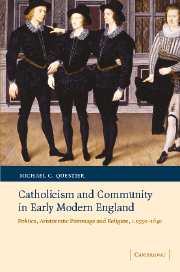 Catholicism and Community in Early Modern England
Catholicism and Community in Early Modern England Published online by Cambridge University Press: 06 July 2010
Let us start with a basic question. How did the family and entourage of a successful service noble (the first Viscount Montague) become, in the later sixteenth century, associated with a strain of Catholicism which was so critical of the regime of Queen Elizabeth, the daughter of the sovereign whom Sir Anthony Browne (d. 1548), the viscount's father, had served through thick and thin?
If we want to reassemble and sketch out the Brownes' mid- and later sixteenth-century reputation for Catholicism there are worse ways to start than by trying to recover the formative political experiences of Sir Anthony Browne (the future first viscount). In all probability, he was heavily influenced by the fact that his father, Sir Anthony, Henry VIII's standard bearer, master of the horse and roving military supremo, was an unashamed Francophobe. Partly as a consequence of his dislike of the French, the elder Sir Anthony did not conceal his disapproval of the king's decision to cast aside Katherine of Aragon. He was hauled over the coals in June 1536. He openly stated that he had never considered Henry's divorce to be a lawful separation. He was quizzed as to ‘whye he should have such affection’ to Princess Mary, whose restoration to the succession was currently at issue, following the execution of Anne Boleyn, although Mary was refusing to submit to the king's demands.
To save this book to your Kindle, first ensure [email protected] is added to your Approved Personal Document E-mail List under your Personal Document Settings on the Manage Your Content and Devices page of your Amazon account. Then enter the ‘name’ part of your Kindle email address below. Find out more about saving to your Kindle.
Note you can select to save to either the @free.kindle.com or @kindle.com variations. ‘@free.kindle.com’ emails are free but can only be saved to your device when it is connected to wi-fi. ‘@kindle.com’ emails can be delivered even when you are not connected to wi-fi, but note that service fees apply.
Find out more about the Kindle Personal Document Service.
To save content items to your account, please confirm that you agree to abide by our usage policies. If this is the first time you use this feature, you will be asked to authorise Cambridge Core to connect with your account. Find out more about saving content to Dropbox.
To save content items to your account, please confirm that you agree to abide by our usage policies. If this is the first time you use this feature, you will be asked to authorise Cambridge Core to connect with your account. Find out more about saving content to Google Drive.